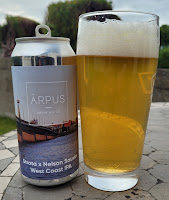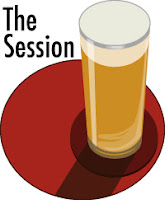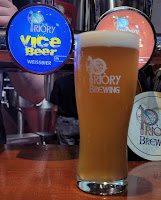
It's Whiplash again. A note of appreciation, first of all, for their tendency to release new beers in groups rather than trickling them out one at a time. It makes hunting them down that much easier. And hunt them down I did.
Something light to kick us off:
Nine Storey Pagoda, a sour ale of 3.8% ABV, brewed with pineapple and Thai basil, created in collaboration with Dublin restaurant Big Fan. There was a time, not long ago, when such a proposition would have seemed exotic and exciting. Now it's just "of course there's one of these in the set, let's see how they did," so let's see how they did. The opaque yellow colour and short-lived head are fairly normal, and the aroma is very much as advertised, introducing a measure of non-specific tropical fruit plus a stronger herbal greenness. I don't think I would have been able to identify the specifics unaided, however. The texture is heavier than I expected, but it still has enough of a tartness early on to give it the refreshing quality which I think it was designed for. A savoury saline tang follows the initial sour kick, and then the fruit and herbs land on the palate simultaneously, though not necessarily in a complementary way. Syrupy pineapple and oily basil leaf might work well together in food but didn't work for me in a beer. It's jarring and a bit busy. I certainly wouldn't recommend this as a restaurant beer. It's an interesting novelty and no more than that.

Of course, this post is going to be mostly about hoppy stuff, and that commences with
Flowers and You, a pale ale. It is indeed very pale, a wan yellow shade, and very heavily murked. The hops aren't specified, and they're not terribly prominent in the aroma, offering a slight peachy tropicality, but next to a worrying dry chalk dust effect. Both are present in the flavour, but neither seeks to dominate. There's a little stonefruit element, given an oily herbal backing of eucalyptus or aniseed, and then a tongue-coating rasp of plasterboard or flint. The finish is that hot, leafy, hop-dreg thing which tends to signify either the end of the barrel or an achingly hip beer, this being the latter, of course. It's only 4.5% ABV and that does mean that all flavours, good and bad, aren't especially strong. Regardless, it's still something of a clichéd haze disaster, showcasing features which have somehow become acceptable, nay desirable, to a beer-drinking public with degenerate tastes. What're ya gonna do?

Raising the oompf to 4.8% ABV brings us to
Under the Eaves, one of those beaten-egg coloured hazy pale ales. I liked the sound of the advertised hop combination of Cascade, Simcoe and Vic Secret, and the aroma has that resinous pine-herb effect I would expect, though more than a hint of disturbing chalk as well. It's silky smooth and barely carbonated; heavily textured and very easy to drink. The front flavour is an almost west-coast citrus bite, but the New England character asserts itself quickly, adding mandarin segments and apricot. I don't know which of the three hops is responsible for that. And then there's the dreggy murk, teaming up annoyingly with the harder bittering to make the beer hotter and harsher than a pale ale of this strength ought to be. So, it's haze-compromised for sure, but I still enjoyed it. The lively hops do enough to keep things fun and hold the nasty grit in check. Vic Secret: my hero.

Paying tribute to Dublin's coolest neighbourhood (at least according to our fair city's estate agents),
The Batter is described by the brewery as "Italo Disco Pils". It's 5.2% ABV and hopped with an all-noble combination of Saaz, Hersbrucker, Perle and Saphir. Pale to the point of appearing white-gold, it's faintly misted with haze and shows very little head retention after an initially frothy pour. I expect Italian-style pils to smell of American hops, and this does indeed have a lemony element which could well be some Pacific variety. It goes more herbal on tasting, with sweet coriander and fennel up front, then a gentler bitter lemongrass effect on the end. All is subtle and genteel, buoyed up by a body that's full without seeming heavy. The name and style may be banter-tastic, but the beer is refined and classy, adding some entertaining modern hop twists on a very classic continental lager. No doubt it won't be around long, so catch it if you see it.

And we're back on the haze again with
Hybrid Moments, another murky yellow one, though looking a little thinner than the previous pale ale. This is an American-style wheat ale, 5.5% ABV and hopped with El Dorado and Comet. The big stack of foam on top fades quickly, so the initial weissbier impression was short lived. There's not much aroma, but I got a slightly eye-watering nutmeg spice and a hint of stonefruit beneath. The wheaty texture is the first impression it gives on tasting, beautifully soft and smooth, the carbonation no more than strictly necessary. I was expecting bigger hops, however. What's there is rather savoury, suggesting basil and thyme, with a slightly meaty or sweaty tang. A bit of lemon? Yes, but just a bit. While this is easy drinking stuff, and inoffensive, it's
not the first time this year I expected rather more wallop from a Whiplash beer. Top marks for mouthfeel is a poor consolation prize.

Possibly intended as a companion to Under the Eaves, released in the same tranche, is
Above the Clouds. I'm well used to Whiplash's "west coast" IPAs turning out hazy, and this is no exception, my fingers only blurrily visible through a glass of it. Columbus is the only American classic hop involved; otherwise it's Kiwis Nelson Sauvin and Nectaron. Unsurprisingly, that gives it a strongly tropical aroma: softly sweet, like ripe mango and honeydew melon. It's a dense affair, and I was surprised by the viscous resistance of the first pull. I guess that shouldn't be surprising at 6.8% ABV, though I know Whiplash can do such things with a lightness of touch. This is a firmer stroke, and with the weight comes a boozy heat. It doesn't have any crystal malt, but there's an echo of that kind of sweeter depth from the copious amounts of Caramalt and Munich which seem to have been employed. All of that has muted the hops a little, unfortunately. There's still a measure of Nelson's unmistakable brambly mineral sharpness, and a certain pithy citrus, but not the fleshy tropical fruit of the aroma. After the initial confusion, I made my peace with it. This does present most of the things a drinker would want from a west-coast IPA: big of substance, booze you can feel, and hopping which is piquant, edging onto aggressive. I've taken us a roundabout route with this one but it's very good: a delightful slice of hefty hop fun.
In search of a conclusion, it shouldn't be a surprise that the two clearer beers were my favourites. I know for a fact that Whiplash can do murky without the muck, so it was disappointing to find that telltale dregginess in several of these. And since nobody else seems to be calling it out, that's up to me.
 Today's random exotic picks from the off licence are all by the Helsinki brewery CoolHead.
Today's random exotic picks from the off licence are all by the Helsinki brewery CoolHead. The ABV increases to a pokier 6.5% for the next one, called Nova. They say this is a "modern" take on west-coast IPA, because the Idaho 7 hops were added in DynaBoost™ and Cryo forms, in addition to Simcoe and Mosaic. Does that make it a better beer? This one is paler but still a little hazed up. There's less of a hop flavour, and I'm sure that wasn't the intention from using the proprietary tech. What's there is a dry, rasping grapefruit rind effect. It's quite abrasive and, despite the extra strength, there's no extra malt to help soften the smack. This definitely does have an authentic west-coast feel, and is particularly akin to the sharper and paler examples -- I was never as much of a fan of those. Although it's clean, the hop oils do sit on the tongue somewhat, giving it a long finish and aftertaste of dank resins. I hope the vocabulary of this review is pressing the buttons of any west coast aficionados reading, because this is very much in their wheelhouse, even if I found it a smidge too overweening.
The ABV increases to a pokier 6.5% for the next one, called Nova. They say this is a "modern" take on west-coast IPA, because the Idaho 7 hops were added in DynaBoost™ and Cryo forms, in addition to Simcoe and Mosaic. Does that make it a better beer? This one is paler but still a little hazed up. There's less of a hop flavour, and I'm sure that wasn't the intention from using the proprietary tech. What's there is a dry, rasping grapefruit rind effect. It's quite abrasive and, despite the extra strength, there's no extra malt to help soften the smack. This definitely does have an authentic west-coast feel, and is particularly akin to the sharper and paler examples -- I was never as much of a fan of those. Although it's clean, the hop oils do sit on the tongue somewhat, giving it a long finish and aftertaste of dank resins. I hope the vocabulary of this review is pressing the buttons of any west coast aficionados reading, because this is very much in their wheelhouse, even if I found it a smidge too overweening. I needed a palate-cleanser after that, and CoolHead is offering me a "nordic sour" with Ginger Sour. All of these three were consumed al fresco on a warm day, and I thought this one in particular was aimed at such a context. It's only 4% ABV but pours a dense-looking carrot-juice orange. It smells of bready ginger cake, and the sourness makes itself felt in the foretaste: tangy, acidic, and just stopping short of harsh. The ginger arrives in shortly afterwards, and it's the raw, shredded sort found in Chinese cookery as it's practised round my way. The mixture of tartness and spice works rather well, both providing their own sort of invigorating scrub for the palate and throat. Like the first IPA, it is surprisingly robustly textured, a sugar weight making it taste a bit like Canada Dry-type ginger ale, where there's a generous amount of sugar accompanying the spice. I wouldn't say that this is the light refresher I was expecting. Instead, it's more of a full-on culinary experience, to be sipped and savoured. It's nicely done.
I needed a palate-cleanser after that, and CoolHead is offering me a "nordic sour" with Ginger Sour. All of these three were consumed al fresco on a warm day, and I thought this one in particular was aimed at such a context. It's only 4% ABV but pours a dense-looking carrot-juice orange. It smells of bready ginger cake, and the sourness makes itself felt in the foretaste: tangy, acidic, and just stopping short of harsh. The ginger arrives in shortly afterwards, and it's the raw, shredded sort found in Chinese cookery as it's practised round my way. The mixture of tartness and spice works rather well, both providing their own sort of invigorating scrub for the palate and throat. Like the first IPA, it is surprisingly robustly textured, a sugar weight making it taste a bit like Canada Dry-type ginger ale, where there's a generous amount of sugar accompanying the spice. I wouldn't say that this is the light refresher I was expecting. Instead, it's more of a full-on culinary experience, to be sipped and savoured. It's nicely done.






















